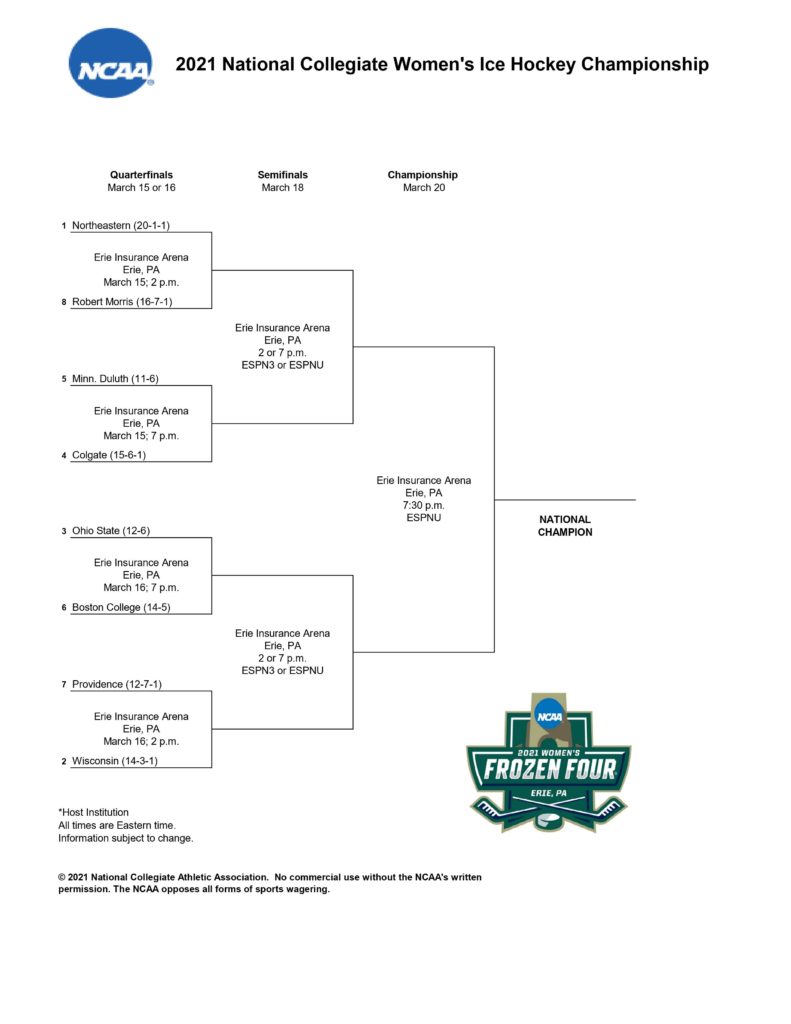The bracket for the women’s NCAA tournament was announced Sunday evening. Northeastern received the number one overall seed. The other teams, in order, are Wisconsin, Ohio State, Colgate, Minnesota Duluth, Boston College, Providence and Robert Morris.
Quarter final games are normally hosted on the campus of the higher seed, but this year, the NCAA consolidated the tournament and the women’s tournament will take place at one site – Erie, PA – over the course of a week.
Northeastern will play Robert Morris at 2 pm est on Monday, March 15, followed by Colgate vs. Minnesota Duluth at 7 pm est. On Tuesday, March 16, Wisconsin will play Providence at 2 pm est and Ohio State will play Boston College at 7 pm est. The semi final games will be on Thursday, March 18, with the championship played on Saturday, March 20.
 The announcement of the field came as a shock to many – most notably, the absence of the University of Minnesota, who’ve been ranked anywhere between 1-4 in the national polls all season. Speculation heading into the selection show seemed to center on whether the WCHA would receive four bids, but consensus seemed to be that the fourth team in the conversation was UMD. Instead, it was the Gophers left out – the first time in 13 years that they will not play in the NCAA tournament.
The announcement of the field came as a shock to many – most notably, the absence of the University of Minnesota, who’ve been ranked anywhere between 1-4 in the national polls all season. Speculation heading into the selection show seemed to center on whether the WCHA would receive four bids, but consensus seemed to be that the fourth team in the conversation was UMD. Instead, it was the Gophers left out – the first time in 13 years that they will not play in the NCAA tournament.
Not sure whether I'm more shocked that Providence got in over Minnesota or Minnesota Duluth, as the 5th overall seed, jumped the Gophers after being swept in Duluth.
First time #GWH misses the NCAA Tournament since 2007.
— Nate Wells (@gopherstate) March 8, 2021
Women’s hockey: Gophers shocked to be left out of NCAA field https://t.co/Hlth13rlL7 pic.twitter.com/DOt6YpBZfW
— Pioneer Press (@PioneerPress) March 8, 2021
Boston College seemed the most likely of the bubble teams to make the tournament, but Providence was thought to be an outside shot. Penn State was also hoping to be included.
This year’s selection committee was Minnesota Duluth athletics director Josh Berlo, Cornell deputy AD Anita Brenner, Boston College coach Katie Crowley, Syracuse coach Paul Flanagan and New Hampshire AD Kate McAfee.
Usually, the field is picked using a variety of mathematical formulas like Pairwise, RPI and strength of schedule calculations and the committee is given the leeway to make changes to the ensuing pairings to reduce flights. Using a single site this year removed that variable, but the lack of intra-conference play rendered the usual math useless.
Per a memo on February 16 that was sent to DI Athletic Directors, head coaches and Sports Information Directors by Anita Brenner, the chair of the NCAA National Collegiate Women’s Ice Hockey Committee, the criteria used to choose the field this year were as follows:
The criteria include (in no particular order):
• Won/Loss Record
• Strength of Schedule
• Head-to-Head Results (when available)
• Results vs. Common Opponents
• Quality Wins
• Home/Away Weighting
• Eligibility and availability of student-athletes
The memo also stated that the committee “will not be using the Pairwise comparison as the primary determinant for at-large selection and seeding; however, the various criteria that have made up the Pairwise and the RPI will be used during the selection and seeding processes.”
Without the clear math this year, the committee had a lot more leeway to make decisions and it appears they took that opportunity to heart.
However, national poll voters did not agree with the choices.
Monday’s USCHO poll:
1. Northeastern (13) 148 pts
2. Wisconsin (2) 137 pts
3. Ohio State 119 pts
4. Colgate 102 pts
5. Minnesota 79 pts
6. Minnesota Duluth 66 pts
7. Boston College 57 pts
8. Penn State 48 pts
9. Providence 25 pts
10. Robert Morris 17 pts
It appears the committee both decided that only three WCHA teams should make the tournament and that Minnesota Duluth was the third-best team in the conference.
The question is how they decided UMD was ahead of Minnesota.
Minnesota Duluth had a higher win percentage having played three fewer games and six fewer games against the Badgers and Buckeyes. That seems like the only situation that favors UMD.
The two teams played just two games against each other and Minnesota won both games. The very fact that the committee holds the Bulldogs in such high esteem should give even more weight to these wins.
Both teams lost in the conference tournament semi-final. Both teams had the same number of wins over Wisconsin and Ohio State. The Gophers swept their games against the rest of the conference. The Bulldogs lost to a two-win Bemidji State team.
The aforementioned calculations aren’t useful to compare across conferences, but are helpful when understanding how teams rank against each other within conferences. RPI, Krach and Pairwise all say Minnesota was significantly statistically better than Minnesota Duluth.
It appears the committee looked simply at win-loss record and finish in the conference and used that to justify the choice.

